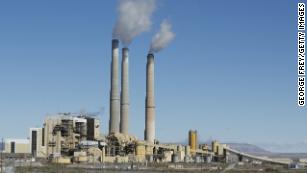By Andrew Steer
Updated 1656 GMT (0056 HKT) October 8, 2018
By Andrew Steer
Updated 1656 GMT (0056 HKT) October 8, 2018
Undeniable Climate Change Facts
Andrew Steer is the President and CEO of the World Resources Institute, a global research organization that works in more than 50 countries. Dr. Steer joined WRI from the World Bank, where he served as Special Envoy for Climate Change from 2010 - 2012. The opinions expressed in this commentary are solely those of the author. See more opinion at CNN.
(CNN)For decades, the fight against climate change has focused on reducing greenhouse gas emissions. But it is now clear that these measures on their own -- however rapidly they accelerate -- will no longer be enough to prevent dangerous climate change. We must now also urgently take carbon out of the atmosphere.
The new blockbuster climate report by the Intergovernmental Panel on Climate Change of the United Nations makes two things startlingly clear. First, we must massively accelerate the decarbonization of the global economy. This will require rapid system-wide transformations in the way we build our cities, generate energy, grow food and manufacture goods. And second, we must capture carbon right out of the air.
 Andrew Steer
The report finds that all pathways to limit warming to 1.5 degrees C (2.7 degrees F) rely on carbon removal.
Andrew Steer
The report finds that all pathways to limit warming to 1.5 degrees C (2.7 degrees F) rely on carbon removal.
It may sound like science fiction, but it's not. Last month, World Resources Institute published a series of research papers that offer a clear-eyed view of the challenges and opportunities of six ways to remove carbon from ambient air. The assessment shows that far from being optional or a distraction, carbon removal, combined with reducing emissions, is critical to limit warming and ensure a safer future.
The obvious starting point is to use nature. Trees have been storing carbon in trunks and roots for millions of years. By restoring forests and degraded lands and using smarter farming practices, we can capture much more. There is overwhelming evidence that these natural solutions can pay for themselves quickly, improving food security, creating jobs, reducing poverty and extracting billions of tons of carbon.
Carbon is simply too valuable to leave it up in the sky!

Undeniable Climate Change Facts
Andrew Steer is the President and CEO of the World Resources Institute, a global research organization that works in more than 50 countries. Dr. Steer joined WRI from the World Bank, where he served as Special Envoy for Climate Change from 2010 - 2012. The opinions expressed in this commentary are solely those of the author. See more opinion at CNN.
(CNN)For decades, the fight against climate change has focused on reducing greenhouse gas emissions. But it is now clear that these measures on their own -- however rapidly they accelerate -- will no longer be enough to prevent dangerous climate change. We must now also urgently take carbon out of the atmosphere.
The new blockbuster climate report by the Intergovernmental Panel on Climate Change of the United Nations makes two things startlingly clear. First, we must massively accelerate the decarbonization of the global economy. This will require rapid system-wide transformations in the way we build our cities, generate energy, grow food and manufacture goods. And second, we must capture carbon right out of the air.

Andrew Steer
The report finds that all pathways to limit warming to 1.5 degrees C (2.7 degrees F) rely on carbon removal.
It may sound like science fiction, but it's not. Last month, World Resources Institute published a series of research papers that offer a clear-eyed view of the challenges and opportunities of six ways to remove carbon from ambient air. The assessment shows that far from being optional or a distraction, carbon removal, combined with reducing emissions, is critical to limit warming and ensure a safer future.
The obvious starting point is to use nature. Trees have been storing carbon in trunks and roots for millions of years. By restoring forests and degraded lands and using smarter farming practices, we can capture much more. There is overwhelming evidence that these natural solutions can pay for themselves quickly, improving food security, creating jobs, reducing poverty and extracting billions of tons of carbon.
Carbon is simply too valuable to leave it up in the sky!

Around the world the message is getting through. In Africa, for example, 27 countries now have plans to restore more than 100 million hectares (250 million acres) of degraded land.
Beyond this, mechanical approaches to pluck carbon from the sky are being demonstrated in California, British Columbia and Switzerland. This approach is expensive, but costs have come down markedly. In 2011, a review panel of the American Physical Society estimated the cost of direct air capture to be more than $600 per ton of carbon dioxide. Today, even without a major publicly funded research and development push, the projected cost range has dropped to between $94 and $232 per ton.
Some still worry that carbon removal tech is a pipe dream, that it is too costly and will never reach levels needed to help rein in climate change. Yet technological innovation always feels impossible until it happens. Consider the story of solar power. When developed in the mid-20th Century, the first one-watt solar cell cost $300. By the 1970s, the cost had dropped to $79. Today, solar cells cost only 37 cents per watt.
How did that happen? Public and private investment in research and development and financial incentives unleashed innovation and accelerated adoption of solar power around the world. A concerted, sustained effort to boost carbon removal has the potential to do the same.
Despite the polarized political climate in the United States, there have been steps in the right direction. This year, both California and Hawaii established targets to make the states carbon neutral by 2045 and reach net negative emissions thereafter using carbon removal. Meanwhile, the US Congress recently approved tax credits for carbon capture and storage (CCS), including federal incentives for direct air capture and utilization. Ramping up investments in CCS technology can be a crucial building-block for emerging carbon removal technologies that will depend on the same transport and storage needs.
As with other aspects of the climate battle, delay is the enemy. Investing now in a portfolio of carbon removal approaches will enable us to scale up in the coming decades so they can become increasingly powerful tools in our climate solutions toolkit.
Around the world the message is getting through. In Africa, for example, 27 countries now have plans to restore more than 100 million hectares (250 million acres) of degraded land.
Beyond this, mechanical approaches to pluck carbon from the sky are being demonstrated in California, British Columbia and Switzerland. This approach is expensive, but costs have come down markedly. In 2011, a review panel of the American Physical Society estimated the cost of direct air capture to be more than $600 per ton of carbon dioxide. Today, even without a major publicly funded research and development push, the projected cost range has dropped to between $94 and $232 per ton.
Some still worry that carbon removal tech is a pipe dream, that it is too costly and will never reach levels needed to help rein in climate change. Yet technological innovation always feels impossible until it happens. Consider the story of solar power. When developed in the mid-20th Century, the first one-watt solar cell cost $300. By the 1970s, the cost had dropped to $79. Today, solar cells cost only 37 cents per watt.
How did that happen? Public and private investment in research and development and financial incentives unleashed innovation and accelerated adoption of solar power around the world. A concerted, sustained effort to boost carbon removal has the potential to do the same.
Despite the polarized political climate in the United States, there have been steps in the right direction. This year, both California and Hawaii established targets to make the states carbon neutral by 2045 and reach net negative emissions thereafter using carbon removal. Meanwhile, the US Congress recently approved tax credits for carbon capture and storage (CCS), including federal incentives for direct air capture and utilization. Ramping up investments in CCS technology can be a crucial building-block for emerging carbon removal technologies that will depend on the same transport and storage needs.
As with other aspects of the climate battle, delay is the enemy. Investing now in a portfolio of carbon removal approaches will enable us to scale up in the coming decades so they can become increasingly powerful tools in our climate solutions toolkit.











Đăng nhận xét